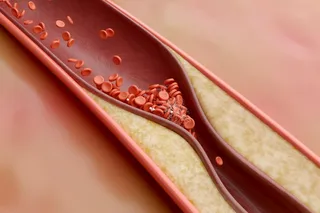The intensive care unit is an oddly quiet place. It swarms with doctors, nurses, respiratory therapists, and medical students, but they confer in low voices, like librarians. The tinny buzz of daytime TV that forms the background noise of most hospital rooms is absent; ICU machinery is nearly noiseless. Lights blink, monitors chirp, respirators sigh.
The man in bed one came here from the emergency room, where he’d appeared one evening complaining of a bad flu. His joints ached, his skin was clammy, he had shaking chills. The doctor noted that one knee was swollen and tender; his patient explained that he’d been rock climbing the previous weekend and had had a fall. Nothing serious, but the fall had convinced him it was time to quit for the day. He’d had a long, soothing soak in the hot tub, then drove home. Two days later he started feeling sick.
Worried by his patient’s pounding heart and rapid breathing, the doctor drew some fluid from the knee and sent it to the lab for immediate analysis. The report confirmed his worst fears: the fluid was swarming with bacteria. This was no flu; it was the early stage of a generalized bloodstream infection, or sepsis. And it was a potential killer.
Sepsis is not one of those medical terms, like coronary, that have made it into the American household vocabulary. Few people outside the medical profession have ever heard of it. Yet all doctors--and particularly all critical care doctors--know and dread the sudden temperature change, the clammy skin, the drop in blood pressure that signal its onset. They are all too aware of sepsis’ deadly domino effect: the progressive shutdown of kidneys, liver, lungs, heart.
Their dread is well founded. Sepsis is the leading cause of death in noncoronary intensive care units; overall it ranks thirteenth among causes of death in the United States. Despite years of research and billions of dollars spent annually, there is still no effective drug treatment, and mortality rates hover around 50 percent. Worse yet, sepsis is on the rise: it now kills 175,000 intensive care patients annually, seven times the rate in 1980.
Why does sepsis haunt our most sophisticated care facilities? Partly it’s because of the nature of the condition itself. Partly it’s because of the nature of the typical ICU patient.
Sepsis is a sort of immunological conflagration that occurs when the body’s response to invasion runs amok. Ordinarily we can handle small- scale incursions of bacteria, fungi, or viruses: our finely tuned immune system absorbs most of them with hardly a tremor. But sometimes, if the invading microbe is especially nasty or if the immune defenses are down, infection becomes generalized and sepsis ensues.
Most cases occur in people already gravely ill from something else--which is why those cases often occur in intensive care units. Modern ICU patients are the sickest patients anywhere, with immune systems that are functioning far from perfectly, if at all. Tiny infant patients, for example, have undeveloped immune systems; very elderly patients have exhausted ones. Organ-transplant recipients have had their immune systems deliberately suppressed to minimize the chance of tissue rejection; people who have sustained massive injuries or burns or major surgery have immune systems that are temporarily nonfunctional. And in a bleakly ironic twist, these patients’ risk of infection is increased by the very devices used to keep them alive: the IV lines, the feeding tubes, the catheters that seemingly sprout from every orifice in their body. Many of these devices pierce the skin, which is home to innumerable bacteria.
Oddly enough, when the man in bed one arrived in the ICU, he wasn’t really typical of modern sepsis patients. He was in robust good health when he somehow encountered the bacterium that would eventually overwhelm his immune system, invade his bloodstream, and send him into a two-month coma. All the same, his hospital course vividly illustrates the intransigence of the disease. He got the best treatment that modern medicine can offer: powerful antibiotics to eliminate his infection, sophisticated mechanical support for his failing organs. Unfortunately, the very therapies used in the attempt to save his life made him cruelly vulnerable to new bouts of infection. By the time of his next encounter with infection, a few weeks after his admission to the ICU, his status as a sepsis victim was grimly typical.
A hundred fifty years ago, when medical technology was much more limited, sepsis was still a killer. But then the chief reason was complete ignorance of sterile technique. When Sir James Young Simpson, the Scottish obstetrician who introduced chloroform as an anesthetic, remarked to a colleague that a man laid on an operating table in one of our surgical hospitals is exposed to more chances of death than was the English soldier on the field of Waterloo, he was admitting what all nineteenth-century doctors knew: systemic infection was their greatest enemy.
In those days sepsis routinely caused surgical intervention to end in disaster. Most surgery consisted simply of amputation, on the theory that removing a badly injured limb and cauterizing the wound to kill exposed tissue was better than risking infection and being unable to prevent its spread. Even with such a cautious approach, however, 25 to 60 percent of those who came under the surgeon’s scalpel died.
Even normal delivery put women at risk for sepsis. One mother in ten entering a Viennese hospital in the 1840s died of a mysterious infection called puerperal fever, now known to be bacterial in origin: doctors there routinely went from the dissecting room to the delivery table without washing their hands or their instruments. The wounds of the living- -in the case of childbirth, the placental attachment in the uterus--were contaminated with pathogens from the dead.
Those were the rates in the controlled environment of a clinic or urban hospital; surgical deaths in military field hospitals could run from 75 to 90 percent. During the Civil War, two-thirds of the Union dead and nearly half the Confederate succumbed not to bullets or bayonets but to infection and disease.
The technological war on hospital infection started in the late 1860s, with Joseph Lister as commander in chief. Lister didn’t know what his enemy looked like--German bacteriologist Robert Koch wouldn’t make the connection between a specific bacillus and a specific disease until 1876-- but that didn’t stop him from mounting his offensive. To the amusement of many colleagues, Lister had a small engine installed in his operating room to spray a constant mist of carbolic acid over the operating field. He poured carbolic acid into wounds; he soaked bandages in it; he scrubbed his own hands in disinfectant until they were raw.
The result? Lister’s surgical mortality rate dropped from 45 percent to 15 percent. Word about his success got around. A Munich hospital crammed with casualties of the Franco-Prussian War adopted Lister’s new methods, and the incidence of gangrene dropped from 80 percent to zero within a week.
Over the next 50 years doctors realized that maintaining a cordon sanitaire around patients was as effective as Lister’s frontal attack against microbes. Surgeons eventually got out of their blood-stiffened gowns; after some foot-dragging they even put on gloves. Hospitals adopted rigorous sterilization of instruments and linens. Hand washing became the norm, and sepsis deaths diminished.
But the man in bed one and the 20 patients an hour who will die of sepsis this year in American hospitals are silent testimony to the persistence of the disease.
As a rule, we are defended against bacterial invasion by a precisely choreographed and still incompletely understood sequence of cellular events. If bacteria contaminate a wound, say, after our skin--one of our front lines of defense--is breached, white blood cells called neutrophils leave the flowing blood and adhere to the blood vessels near the site of the injury. The cells lining the blood vessels--endothelial cells--part slightly to admit the neutrophils into the tissues, where they promptly swallow and destroy most of the bacteria before they can multiply and invade the rest of the body.
Two more classes of immune system warriors--lymphocytes and macrophages--then join the fray. Lymphocytes come in two forms: T cells and B cells. T cells are the organizers, helping coordinate the systemic attack. Among the troops they control are the B cells, which produce antibodies that attack the bacteria directly. Macrophages, meanwhile, are communications specialists. They trigger the production of dozens of powerful molecules, called cytokines, that communicate with the body’s tissues and with one another. Each cytokine is assigned a separate task; for example, one causes a chemical change in the endothelial cells near the infected area that attracts more white blood cells; another raises the body’s temperature to create a less hospitable environment for microbial invaders. The precise function of many others remains unclear. But it is clear that cytokines ensure that the immune response doesn’t escalate indefinitely. Even as some cytokines are signaling for attack, others are produced to temper the response. Eventually, once the invaders have been defeated, the war machinery winds down, leaving cells called fibroblasts to repair damaged tissues.
When the system is working as it’s supposed to, all this action is as precisely choreographed as a minuet. But in a critically ill patient, whose natural defenses have become severely compromised, the sequence is very different. The precise choreography is gone; the minuet becomes a rout. The careful, self-regulating sequence--so many neutrophils, followed by so many lymphocytes, macrophages, cytokines, and so forth--veers wildly out of control. Now battalions of white blood cells penetrate the lining of the blood vessels; hordes of macrophages produce cytokines that further increase the vessels’ permeability. Under assault, the endothelial cells attract more macrophages. They, in turn, produce even more cytokines. The blood vessels become leaky, allowing fluid to penetrate tissues and vital organs.
Now, as the body’s own defenders become its attackers, the response will continue to escalate until the whole system finally spirals into the chaos of septic shock--temperature rises or drops rapidly, heartbeat quickens as blood pressure plunges, and organ systems, lacking an adequate blood supply, begin to shut down in rapid succession.
There are many routes into the body for the bacteria that initiate sepsis--it doesn’t have to be a wound. In the ICU, catheters, monitoring lines in femoral and pulmonary arteries, mechanical respirators, and feeding tubes all provide entryways. A common site of entry is the digestive tract, where large numbers of bacteria, such as Escherichia coli, normally reside. When, as a result of infection, the gut membrane breaks down, E. coli can get into the bloodstream. In an already sick, immunocompromised patient, this can lead to a generalized infection.
Potentially adding to the problem are the antibiotics used to treat such infections. From a microbial standpoint, the human body is like a bus with standing room only; when an antibiotic kills one class of microbes, others multiply to fill the empty seats. The man in bed one, for example, contracted a severe Klebsiella infection several weeks after he entered the hospital. These rod-shaped bacteria ordinarily live harmlessly in the mouth and gastrointestinal tract, but the antibiotics that killed the original infection--by Streptococcus bacteria--allowed Klebsiella to expand to other sites where it could do damage. A month into his stay, the man contracted a Staphylococcus infection; the laboratory cultured it from the tip of one of his five catheters. Whether it originated from his own skin or elsewhere remains unknown.
Sepsis treatment, says one of the more than 30 doctors involved in caring for the man in bed one, is a game of cat and mouse.
What to do? Most hopes lie with researchers in the biotechnology industry, but the outcome of their efforts is still uncertain. The antisepsis drugs that have been produced by more than a decade of research- -none of which have yet obtained Food and Drug Administration approval-- have been called as valuable as penicillin by some doctors and questioned as unconscionably expensive and only marginally effective by others. What is certain is that the enthusiasm the drugs generated in Wall Street analysts and investors during their development stage hasn’t yet been matched by their performance.
The quest for a laboratory-produced antisepsis drug began in 1982, when researchers reported that they’d improved the survival rate of some septic patients by treating them with a new serum. The serum was made from the blood of healthy volunteers who had been injected with small amounts of killed E. coli. These bacteria are one of a huge class known as gram-negative bacteria--negative because of their inability to absorb a purple dye when stained in vitro; gram because that was the name of the Danish doctor who first devised the stain. Another bacteria class, called gram-positive, absorbs the purple stain. Their opposite responses to the stain reflect the two bacterial types’ different chemical makeups, and one of the ways in which they differ is in the poisons they produce. All gram- negative bacteria produce a potent toxin called lipopolysaccharide, which may be one of the substances that can trigger the cytokine cascade that ends in sepsis.
After exposure to the injected E. coli, the volunteers developed antibodies to the toxin; the researchers’ hopes were that antibody-laden serum made from the blood would neutralize toxins in sepsis patients infected not just by E. coli but by any other gram-negative bacteria as well. Apparently it worked: 78 percent of the treated patients survived their battle with sepsis, versus 61 percent for the untreated group. Presumably it was the antibodies that deserved the credit.
It’s economically impossible for biotech companies to make a drug for widespread use by this time-consuming method. But researchers in the then-fledgling biotechnology industry immediately took up the challenge of designing and manufacturing the antibody in the laboratory, so that ICU doctors might have a potent weapon against sepsis. More accurately, they might have a weapon against gram-negative sepsis; the other, gram-positive bacteria do not produce lipopolysaccharide but rather a vast array of individual toxins, each different from the other. Against them the projected drug would be useless. However, in the early 1980s gram-negative bacteria appeared to be responsible for most ICU sepsis deaths, so gram- negative sepsis seemed a logical first target for a biotech attack. The first companies out of the starting gate--XOMA, in Berkeley, California, and Centocor, in Malvern, Pennsylvania--approached the finish together, both with laboratory-produced, highly specific monoclonal antibodies that would bind to the gram-negative bacteria’s toxin.
In 1992, however, after both companies had completed testing their drugs, and as ICUs across the country were gearing up to use them, the Food and Drug Administration slammed on the brakes. It found fault with Centocor’s analysis of its clinical trials--in the agency’s opinion, it wasn’t at all clear that patients who were receiving the drug and surviving longer were indeed surviving longer because they were receiving the drug. The FDA ruled that the drug, called Centoxin, in fact demonstrated no clear evidence of effectiveness. About the same time, the agency ruled that it didn’t have enough evidence to approve XOMA’s drug, called E5. Stung, both companies went back to the drawing board.
One of the chief worries of critics of the drugs at that point concerned expense, which was projected to be some $3,750 a dose. For either drug to be useful, it had to be administered very early, as soon as a diagnosis of sepsis was made. However, these drugs were aimed only at gram- negative bacteria, and determining just what kind of bacterium is causing a particular patient’s infection takes time. The only logical approach, therefore, was to administer the drugs to all sepsis patients, without waiting to identify their particular bacterial nemesis as gram-negative or gram-positive. Obviously, with more than 350,000 cases of sepsis in the United States each year, this would amount to massive expenditures by patients and hospitals and insurance companies, and huge revenues for the drugs’ manufacturers--in Centocor’s case, a projected $1.6 billion a year. Advocates argued that the lives saved would more than justify the added expense of giving a drug to those patients for whom it would be ineffective. But, of course, a company had first to prove to the FDA’s satisfaction that its drug was indeed effective against at least gram- negative sepsis.
The roof fell in January 1993. Centocor abruptly halted its new clinical trials of Centoxin when researchers found that a certain segment of septic patients getting the drug--patients who turned out to have gram- positive infections--had a higher death rate than patients getting a placebo. Centoxin was immediately withdrawn from use in Europe, where it had been approved. Centocor’s stock dropped precipitously.
Today the future of Centocor, once ranked among the most promising biotech firms, is murky. XOMA has begun a new clinical trial for E5, but the company is now putting most of its energies into BPI, a new product that it believes will both bind the toxin and kill the bacteria that release it.
In the face of all this bad news, publicly at least, biotech entrepreneurs still express dogged optimism. Designing an antisepsis drug isn’t terribly difficult, maintains Patrick Scannon, the chemist and doctor who founded XOMA. The problem is in testing it. In the first place, Scannon points out, there is no good animal model for sepsis. This puts sepsis in a different category from the better-known infectious diseases--for example, diphtheria, which looks pretty much the same in rabbits, mice, and humans. In the second place, he asserts, designing clinical trials for antisepsis drugs is just plain harder than designing clinical trials for other therapies, which is why the drugs’ true effectiveness isn’t apparent to everyone. Septic patients aren’t blank slates. The person who gets a drug in a clinical trial may be young or old, immunocompromised or immunologically intact. The surgery (or chemotherapy or medical illness) that preceded sepsis may have been minor or it may have been life-threatening. All these factors muddy the results: a drug may actually work against sepsis, but if the patient dies of an underlying disease, it won’t look that way. Scannon remains convinced that E5 is effective for some sepsis patients, though he acknowledges that the trick will be demonstrating which ones.
Even the second generation drugs now in the pipeline, several of which attempt to intervene later in the cytokine cascade, are having problems. Five weeks after the Centocor recall, an antisepsis drug designed by Synergen to block the cytokine called interleukin 1 was found to have only a minimal effect on survival rates. Additionally, some skeptics argue that because cytokines play a critical role in the normal immune response, suppressing them may have unpredictable side effects; others note that the complexity of the cytokine response may make the suppression of only one cytokine of limited use. More than 30 of these intercellular communicators have been identified, and new ones are constantly being discovered.
Further complicating the picture is the latest Centers for Disease Control report on hospital-acquired infections: it notes that the proportion of hospital infections attributable to gram-negative bacteria has been level since 1980, which is just about the time the biotech industry began to address the problem. For a variety of reasons, including antibiotic resistance, gram-positive sepsis is now on the rise. In other words, in the years since the biotech companies have been working on a weapon against gram-negative sepsis, their target has been moving. Drug designers trying to combat these bacteria will first need to find a property common to all gram-positive bacteria--if there is any--and then devise a drug to join battle with it.
In a cramped and airless conference room down the hall from the ICU, a half-dozen of the doctors and medical students who have been taking care of the man in bed one slump around a conference table, drink bad coffee, and talk about sepsis. Some are in surgical scrubs, some in starched whites; all are glum.
The bacterium that brought the man in bed one to the hospital was a form of Streptococcus called Group A strep. This is the same bug that caused the death of Muppet puppeteer Jim Henson in 1990. It’s also the one that has caused the small clusters of deaths in Arizona and the Rocky Mountain states that have been reported during the past four years.
Researchers are unsure whether Group A strep is an old microbe making a comeback--it produces a toxin similar to that found in the now- rare disease scarlet fever--or a new strain resulting from a recent mutation. Whatever its origins, the bacterium is powerful enough to overwhelm the defenses of even healthy people. When it is inhaled or enters the body through a break in the skin, Group A strep causes symptoms that so closely resemble flu that they may be ignored until it’s too late. Antibiotic treatment, which might be effective in the earliest stages of infection, is nearly useless once the bacteria and the toxins they produce have entered the bloodstream.
The man in bed one may have come in contact with Group A strep via a small scrape sustained in his climbing accident, though it’s impossible to know. Some of the ICU staff speculate that the water in the hot tub may have been inadequately disinfected, but others think this is an unlikely mode of infection; again, no one really knows. And no one is likely to find out: after two months in the hospital, the man in bed one died.
The doctors at the conference table talk about the high hopes they had so recently entertained for the antisepsis monoclonal antibodies; they talk about how much sicker the patients in modern hospitals are; they talk about how good they are at keeping people alive and how frustrating it is to lose those people to infection, medicine’s oldest enemy. As far as I’m concerned, says one, sepsis hasn’t returned. It never really left.














